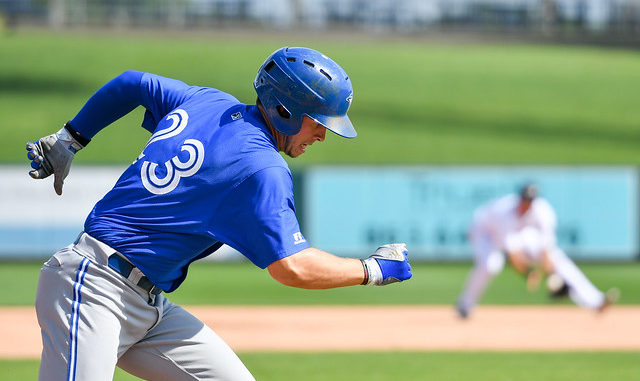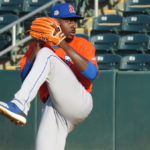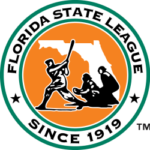
If there’s one position in baseball that has been lacking in offensive prowess in recent years, it’s catcher. I grew up watching players like Mike Piazza, Ivan Rodriguez, Joe Mauer, and Brian McCann who could both defend behind the plate (to varying degrees, certainly) and mash when they got in the batter’s box. Across baseball, there have been fewer and fewer catchers who are consistent threats with a bat in their hands. The Florida State League has not been immune to this phenomenon seen across the sport. Over the past decade, no more than one catcher has finished a season in the top 15 in OPS in a given year in the FSL (OPS stands for on base percentage plus slugging percentage. It’s one of the easiest tools to use to make a judgment of a player’s total offensive output). Through the first month of this season however, there are four catchers amongst the top 15 batters in OPS. Let’s take a deeper look at each one and their performance in the first month to see if they’re just off to a hot start or if this may be a historically good class of catchers beginning the year in the Sunshine State.
1. Riley Adams, Dunedin Blue Jays
.895 OPS, .277 AVG, 3 HR, 3 2B, 18 H, 14 BB, 18 SO, 65 AB
Riley Adams is a 22-year-old prospect who played college baseball at the University of San Diego. He was drafted in the 3rd round with the 99th overall pick and spent last year in the Florida State League with average results at the plate, slashing .246/.352/.361 with 4 HRs in 99 games. This year, however, he’s been playing at another level. He’s hit the ball with authority, leaving the yard three times in his first 19 games. Even more encouraging is his developing plate discipline. Last year, Adams struck out twice for every walk he took. This year, Adams is much closer to an even strike out to walk ratio through the first month of the season.
Adams is an athletic and promising catching prospect who could climb the ranks in the Toronto Blue Jays‘ organization quickly if he continues to show improvement in the batter’s box and behind the plate. At 22, he’s still young for a catching prospect, so while we may not see him playing in the Rogers Centre this year, it’s not out of the question for him to compete for a spot as soon as 2020.
Note: On May 2nd Adams was called up to Double-A New Hampshire along with battery-mate Nate Pearson.
2. Brady Policelli, Lakeland Flying Tigers
.901 OPS, .314 AVG, 4 HR, 7 2B, 3 3B, 32 H, 5 BB, 18 SO, 102 AB
Brady Policelli is a 23-year-old prospect who was drafted in the 13th round in 2016 by the Detroit Tigers. Out of Towson University, Policelli is not the most heralded prospect, but he’s making a name for himself with his offensive production. Out of all the catching prospects in the Florida State League, Policelli has shown himself to be the most well-rounded hitter so far this season. He hits for a high average, and he has the most extra base hits out of this crop of catchers. What stands out the most is his speed which is above average for a catcher. Last season as part of the West Michigan Whitecaps in the Midwest League, Policelli stole 19 bases in 98 games. This year, he’s swiped three bases and also has three triples through his first 22 games.
Policelli has yet to show over the course of a full season that he can maintain this kind of offensive production. He was drafted in 2016, and he has not finished a year in professional ball with an OPS above .712. His current walk rate is also a bit concerning, only taking a walk once every 23 at bats so far this year. But nearly half of his hits have been for extra bases, so he’s squaring up the baseball in 2019. If this is a sign of him taking the next step in his development rather than just having a hot start to the year, the Tigers may have struck gold in drafting Policelli.
3. William Contreras, Florida Fire Frogs
.780 OPS, .309 AVG., 1 HR, 7 2B, 30 H, 9 BB, 20 SO, 97 AB
William Contreras is the youngest of this group at 21 years of age with a Christmas Eve birthday. Signed out of Venezuela when he was 17, Contreras has quickly become the top catching prospect in the Atlanta Braves organization. There’s a lot to like about Contreras. He’s athletic, teachable, and he’s got good genes (his brother Willson currently serves as the backstop for the Chicago Cubs. As a younger brother myself, I’m sure William is sick of this being written in every article about him). Last season, he made a big jump as a hitter. Combined as a Rome Brave and Florida Fire Frog, Contreras slashed .285/.347/.436 with 11 home runs and 36 extra base hits.
Contreras got off to a slow start this year, but over the past 11 games he has been on fire at the plate. During that nine game stretch, Contreras has hit for a .375 average. In a two game span, he went 7 for 9 with 2 walks. He’s currently on pace for career bests in OPS, average, and doubles. He’s been blazing hot and ice cold this year, but if he can find some consistency and maintain his overall level of production, he won’t just be in the conversation for the best catching prospect in the Braves system. He might be considered the best catching prospect in baseball.
4. Ben Rortvedt, Fort Myers Miracle
.809 OPS, .242 AVG, 2 HR, 6 2B, 1 3B, 16 H, 12 BB, 12 SO, 66 AB
Ben Rortvedt is a 21-year-old prospect out of Verona, Wisconsin. Drafted out of high school by the Minnesota Twins in the second round of the 2016 draft, Rortvedt has been highly regarded for his defense and athleticism in the minors. He’s now starting to show marked improvement at the plate. Since 2017, Rortvedt has shown continued progress, climbing over 100 points in OPS year to year. So far this season, he has shown power and patience at the plate with 8 extra base hits and 12 walks in 74 plate appearances.
The most concerning part of Rortvedt’s line is his .242 average. It’s the lowest of these four catchers. However, he walks at the same rate at which he strikes out, and a majority of his hits have been for extra bases. If he can continue to strike out at a reasonable rate, take his walks, and hit the ball hard, he may start climbing up this list quickly.
There’s a lot that goes into evaluating a catching prospect. Catchers have to defend behind the plate, frame pitches, throw out runners, manage a pitching staff, call a game, and master a never ending list of tasks that are vital to the success of an entire baseball team. It’s hard to say how good any of these catching prospects are at the parts of the game that require intangibles like baseball intellect, relational skills, and leadership qualities. But upon examination, they all seem to have average to above average offensive potential. It’s a rarity to see this many catchers with this type of potential as hitters in the Florida State League at one time. It will take a good bit of time to find out, but we could be looking at one of the best offensive catching groups that we’ve seen in years.
Sam is a lifelong baseball fan currently residing in Carrollton, Georgia. While I’m a fan of all Atlanta and University of Georgia sports, I love seeing prospects throughout the minor leagues develop their skills and come into their own. When not watching, listening, and reading about baseball, I spend my time working as a pastor, running, reading playing guitar, and hanging out with my wife, Natasha, and two dogs, Wall-e and Lucy.



Leave a Reply